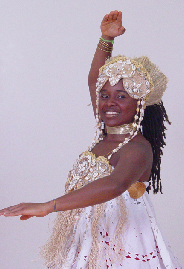
In 1982, Dandha participated in the show Night of the Black Beauty, which marks her debut as a professional dancer for a public of approximately ten thousand people. Since then she remained in Ile Aiye choreographing, dancing, and teaching all over the world, with 22 years in the house she is the longest standing dancer in the group.
Dandha is responsible for high profile stage works in Bahia, including the 50 years of Odebrech Foundation with the Caimmy Family, International Festival of the Children’s’ day in the Liberdade neighborhood, Perc Pan (Panorama Percussivo Mundial) in Salvador and in Paris, and Cultural Latin American Market.
Dandha has participations with the great names of the Brazilian popular
music such as the first DVD by Daniela Mercury, Several shows with Caetano
Veloso, Gilberto Gil, Dorival Caimmy, Carlinhos Brown, Djavan, Milton Nascimento,
Margareth Menezes Elba Ramalho, Orquestra Afro-Bahiana do Pelourinho of
the ethnomusicologist and researcher of folkloric culture of Brazil Emilia
Biancardi, amongst many more.